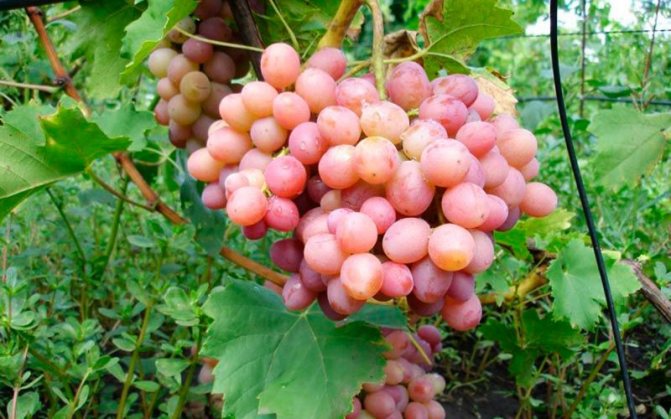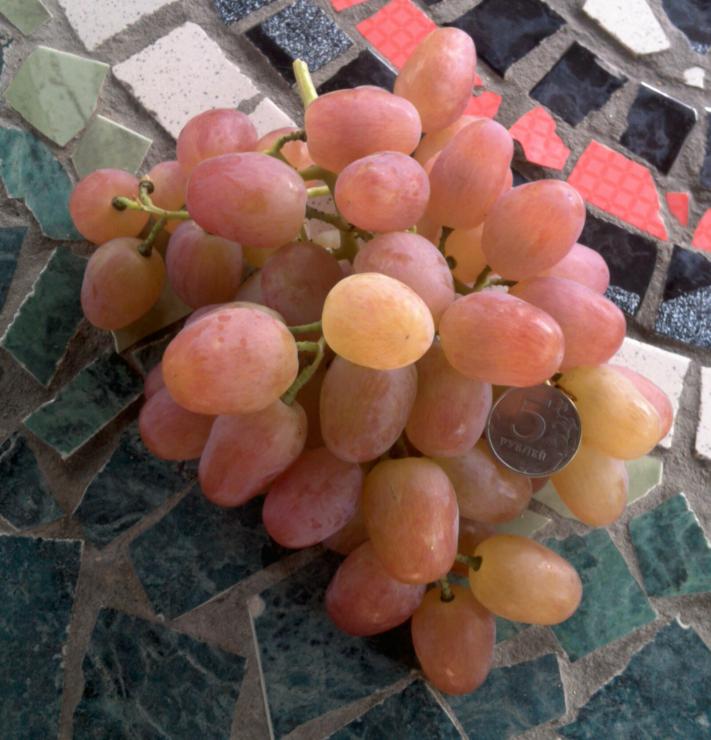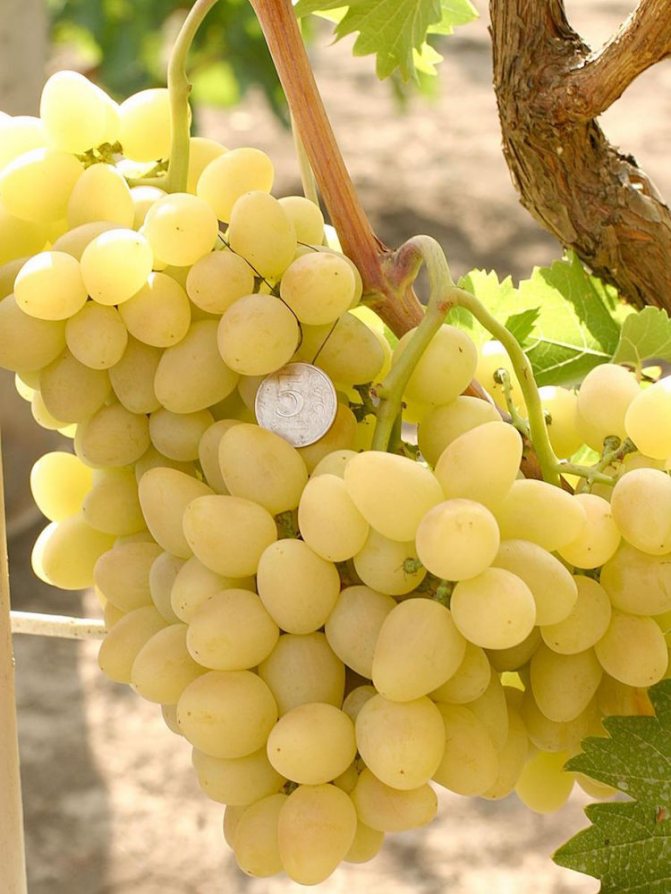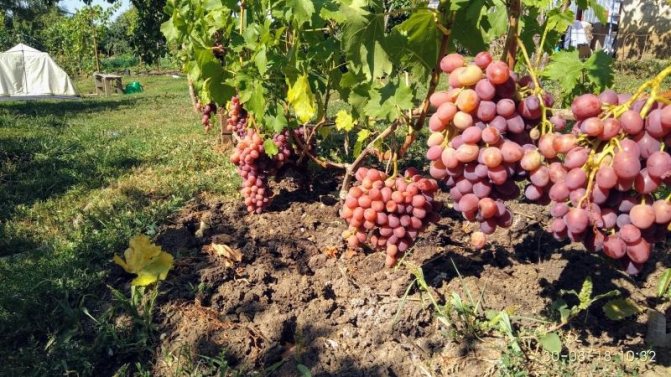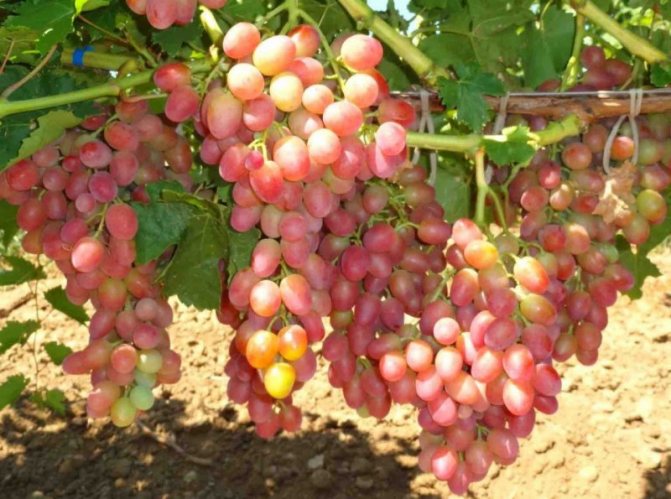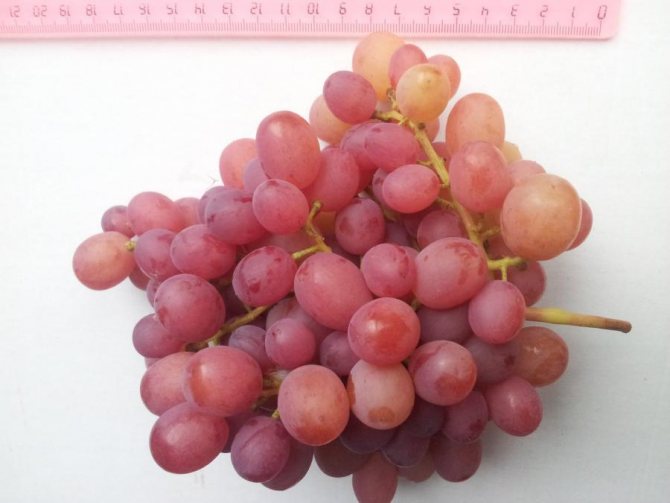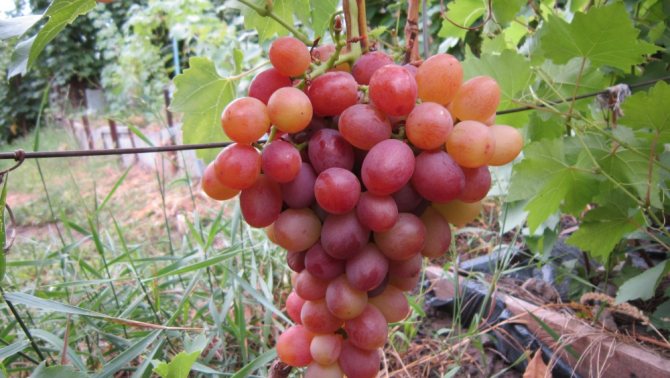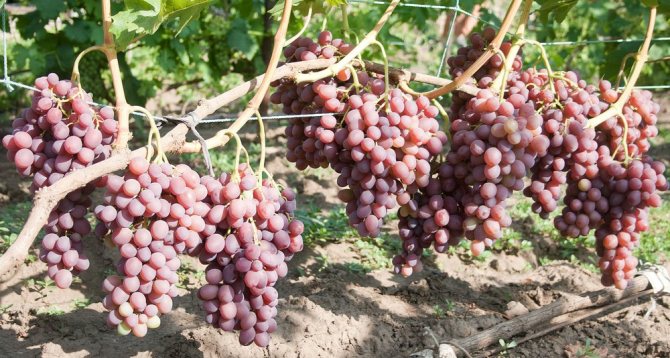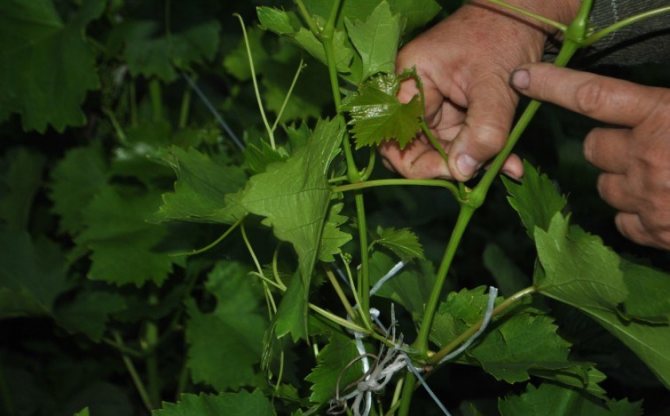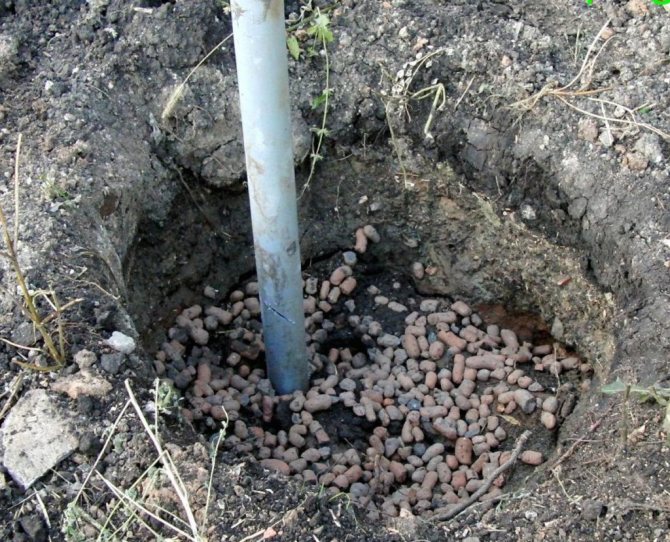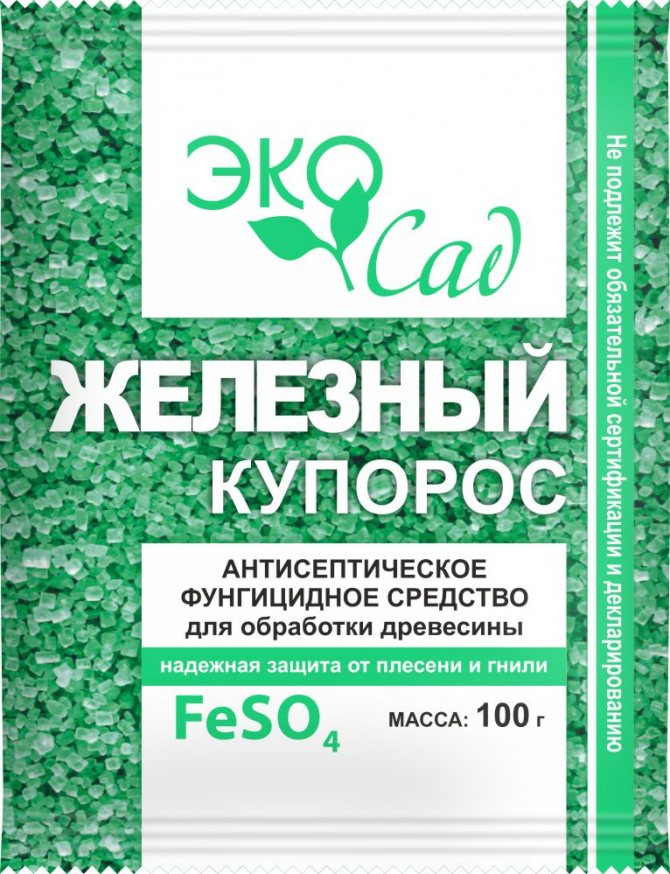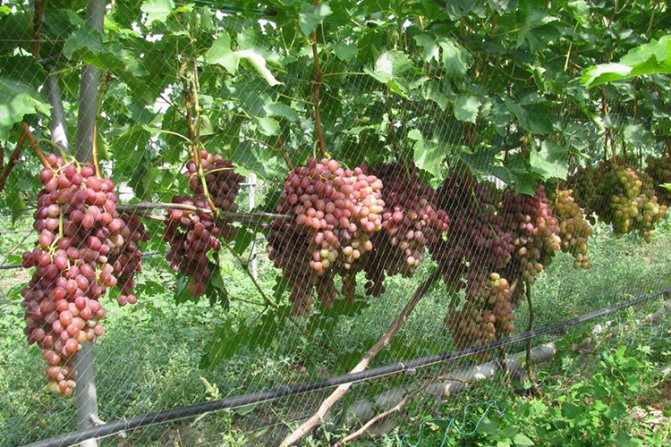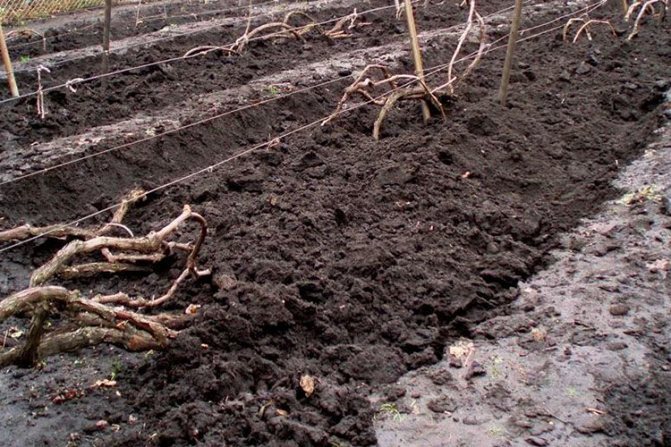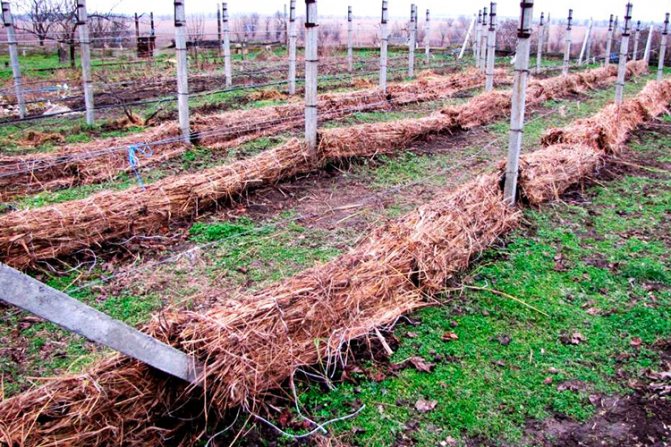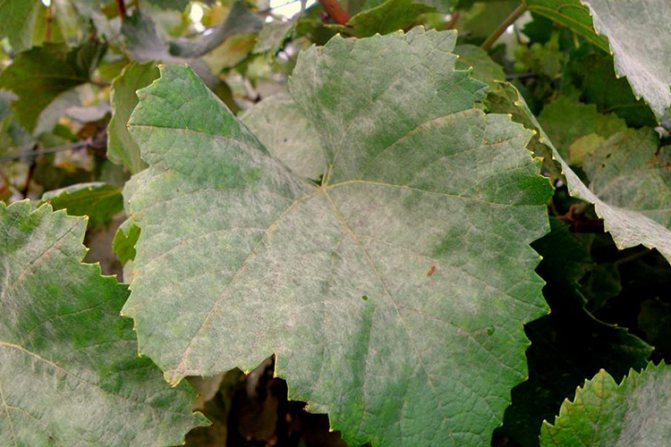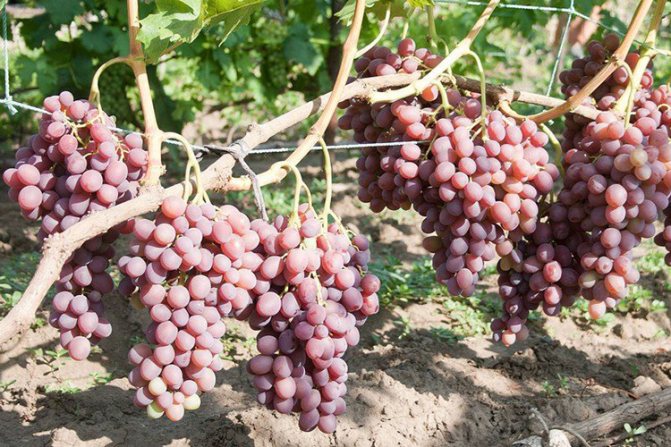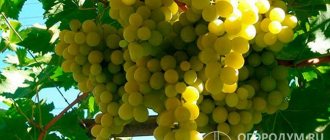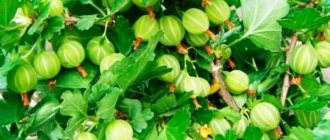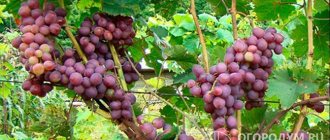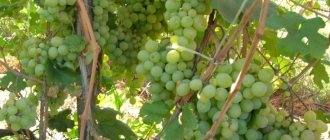The Libya grape is a relatively young variety, but has already won the sympathy of experienced gardeners. Thanks to its varietal qualities, Libya is gaining popularity in private viticulture. Not every gardener is familiar with the description of its properties due to the novelty of this variety of grapes. Useful information about the peculiarities of growing grapes of this variety will help to avoid common mistakes and get a good harvest of sweet berries.
- 2 History of the origin of nutmeg
2.1 Photo gallery: parent varieties and bunch of Libya
- 3.1 Characteristics of the grape variety Libya: its advantages and disadvantages
- 4.1 Basic landing rules
4.2.1 Video: everything about proper grape care
Description of the variety
Libya was bred by the Ukrainian breeder V.V. Zagorulko. In 2011, it was officially registered. The variety reached Russia a few years later - it was included in the State Register only in 2014. The patent holder is VNII "Magarach". The variety is recommended for cultivation in the North Caucasian District.
In the same year, the Livia K variety was included in the State Register, which is similar in many characteristics to Libya. The patent holder of Libya K is the Kuban State University. Trubilin. The novelty is recommended for cultivation throughout Russia.
Adult vines are large, vigorous, with intense vigor. The first lower leaf is formed intact, and the subsequent five-lobed ones with an average dissection. Pubescence is absent. Young shoots are light brown.
The grape of Libya belongs to the early varieties: from the formation of the ovary to the onset of ripeness, it takes about a hundred days. When the brushes are evenly loaded, the berries ripen at the same time. When the vine is overloaded, not the entire crop ripens, but only seventy percent.
The Libya grape gives a smooth, cylindrical brush with a length of more than twenty-five centimeters and weighing up to one and a half kilograms.
Bisexual inflorescences are formed on the plant, which do not require planting a number of pollinating bushes. The first fruits appear around the fourth year after planting. The number of fruiting shoots is high - about eighty percent in relation to the total number of branches.
Usually, annual shoots have time to fully mature by the end of the growing season. When the vine is overloaded with the harvest, the ripening of the shoots is only 80%. Because of this feature, gardeners need to normalize the load.

Libya Berries
The grapes are large. The berries are egg-shaped, up to two centimeters wide and up to 3 cm long, the weight of one berry is 11-13 grams.
The peel of the fruit is pink, soft, almost invisible. The pulp is fleshy, juicy, which is why the variety is of particular value.
The palatability of the fruit is excellent. According to reviews, a description of the variety, the Libya grape, a photo of which can be seen in the article, has a delicate, sweet nutmeg aroma. Even during long-term storage, the taste does not change.
The variety contains a lot of sugars - up to eighteen percent with an acidity of seven percent.Each berry contains up to three seeds, which are easily separated from the pulp.
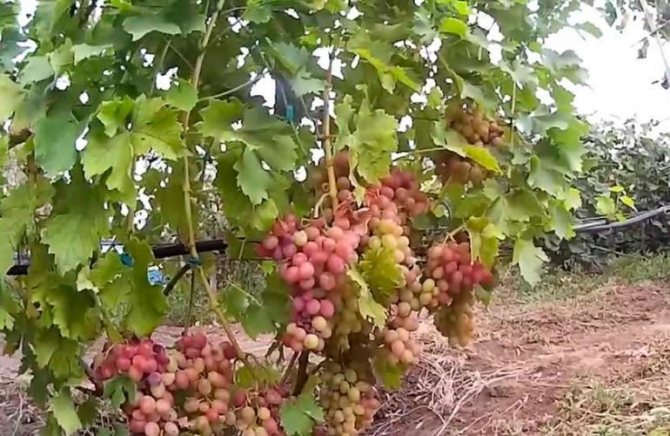

Fruit characteristics
The bunches are very massive, conical, of medium density, weighing about 600-700 g, maximum - more than 1 kg. The berries are large, weighing 5-9 g (up to 13.5 g), do not crack.


Bunches often weigh more than 1 kg
In the main collection, the fruits are ovoid in shape. All shades of pink are present in the color of the skin - from light pink (in the shade) to red-violet (on the sunny side). The skin is relatively firm, of medium thickness, and easily eaten. The pulp is juicy, fleshy, crispy, harmonious sweet taste, with pronounced nutmeg notes, very aromatic. The number of seeds (seeds) in the pulp of berries is very small - 1-3 pieces.
Professional tasting assessments of taste - 9.3 points (out of 10), most summer residents find the taste "special" nutmeg, "refined".
Biochemical studies carried out by specialists from the Magarach Research Institute to determine the nutritive value of the fruits revealed that in the agro-climatic conditions of the South Coast, the sugar content of Libya was 14.6% at an acidity of 7 g / l, which ensures a very harmonious ratio.


Dessert fruits (universal) - great for fresh consumption, they are used to make jams, confitures, compotes, juices, raisins
Disadvantages and advantages of the variety
The characteristics of Libya's grapes determine its strengths and weaknesses. The first include:
- Early ripening.
- Excellent taste.
- Attractive brushes. The bunches are large, the average weight is six hundred grams, and the mass of individual ones can reach 1.5 kilograms or more.
- The variety is able to maintain its qualities for a long time.
- Yield stability. With proper care, 25-30 kilograms of berries are harvested from one vine.
- Long-term storage. The harvest can be stored for up to thirty days.
The disadvantages include:
- Some gardeners note the lack of color of the berries.
- The variety is not resistant to mildew and powdery mildew.
- The need for winter shelter. The variety can withstand up to -21 degrees of frost. Due to its low frost resistance, the variety is recommended to be grown only in the southern territory of Russia. Even in the north of the Rostov region, vines can freeze out.
Berries of the variety are very attractive to wasps. Because of this, the bunches must be covered with a net so that insects do not damage the crop.
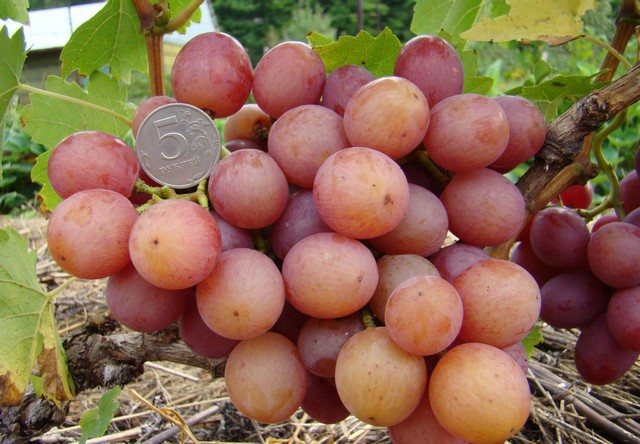

Yield
Differs in accelerated ripening and frost resistance, for which it is especially appreciated in Russia. The crop can be harvested in the third season, the fruits reach ripeness in 3-3.5 months in favorable weather, even in cool climates.
The vineyard produces 25-30 kg per bush, and in agriculture - almost 170 centners (17,000 kg) per hectare.
Note! In the cut state, Libya grapes are stored for 30 days, without losing their freshness, without withering.
Libya grapes ripen early, literally in 100-110 days. It produces large miracle berries of 8-15 g, each almost 3x2 cm in size, like a 5-ruble coin.
The brushes are huge, densely sprinkled, grow up to a quarter of a meter long and weigh from 600 g to 1 kg. There are no small berries, the so-called "peas".
Read more: Planting garlic in the fall before winter care and harvesting
Landing features
Features of growing grapes in Libya are in the right choice of planting site, pruning and care.
It is necessary to plant the variety in a well-lit area, providing it with vertical weaving. The southern directions of the courtyard are best suited. The place must be protected from drafts.
There are no special requirements for the type of soil. When grown on scarce soils, regular feeding is carried out. Although, according to the description of the variety, reviews, the grapes of Libya, the photo of which gives an idea of the size of the fruit, gives the best yields when growing vines on black soil, loamy lands with deep groundwater.
The landing pit is prepared in advance. It should be several times larger than the root system of the cutting. Humus mixed with fertile soil is laid in the pit.
The seedling is placed in the hole so that the root collar remains above the ground. The plant is carefully covered, a support is placed on the north side.At the end of planting, the grapes are watered.
If the root system of the seedling is underdeveloped, then it is recommended to treat it with a root formation stimulator before planting.
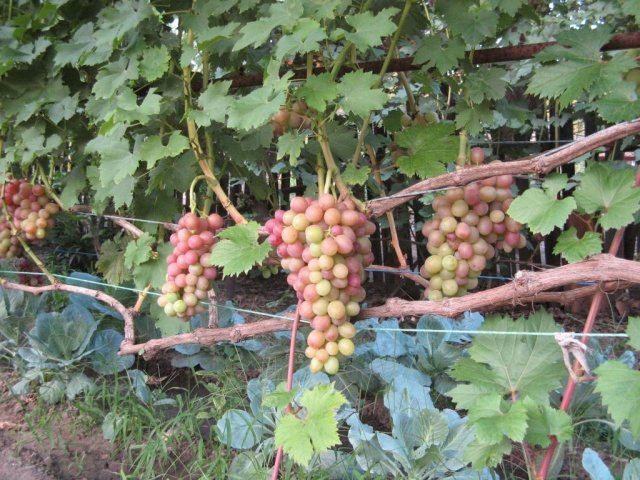

Libya grapes: planting seedlings
Planting grape seedlings Libya, it is necessary to choose a suitable site and observe the landing time.
Photo of grape tree Libya
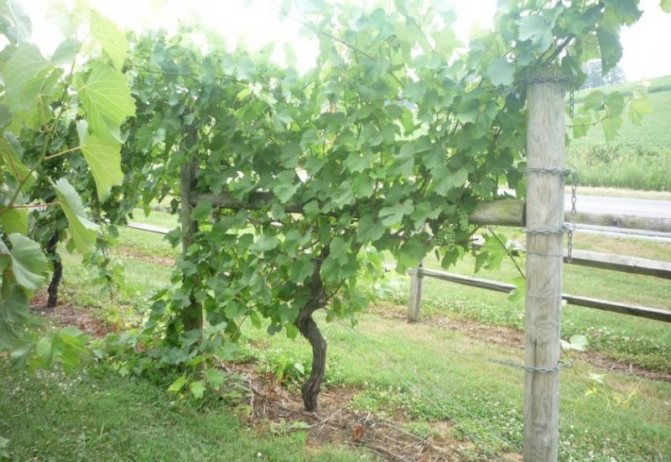

In the southern regions, it is recommended to plant Libya grapes in the fall after the foliage has fallen. Saplings need no more than a month to adapt to a new place and get stronger enough before the coming winter.
In the spring, the Libya variety is planted less often, usually a similar procedure is performed after the snow has completely melted and the soil has warmed up to 14-16 degrees Celsius.
Caring for grape seedlings immediately after planting - video
The place where these vines will grow should be located in the southern or western part of the garden plot.
To protect this crop from gusts of cold winds, it is recommended to prepare ridges for planting next to a fence or wall of garden buildings.
It is impossible to plant a plant in a lowland - a large amount of moisture accumulates there.
It's important to know!
Vine bushes should not be planted near fruit trees that will shade them. The distance from the vineyard to them must be at least 5 m.
Usually, seedlings of this variety are purchased in specialized nurseries, from where they are sent in containers with a closed root system. Before planting, the shoots are cut off, leaving no more than 4 eyes on them.
Planting holes for planting grape seedlings in Libya are prepared in advance - about a month in advance.
Their size should be about 80 cm, and the depth - 70 cm. A layer of drainage material up to 15 cm thick is laid out at the bottom. As a drainage, you can use large expanded clay or crushed stone.
Photo of grape planting scheme
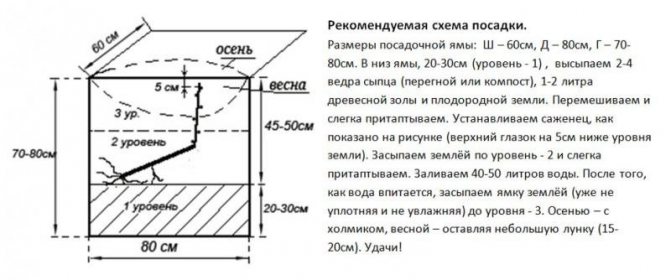

The next layer (about 30 cm thick) is a mixture of black soil, potassium sulfate (140 g) and superphosphate (200 g). And black soil is poured to the top of the pit. Up to 50 liters of water is poured into each pit, and the pits are left for shrinkage.
When planting, a mound is made in the center of the pit, on which the seedling is installed, and its roots are carefully straightened along the slopes. Then a nutritious substrate is poured into the pits, tamped and brought under each plant 20-30 liters of water.
How to care
Libya grapes, planting and caring for which are simple, gives a large harvest if the recommendations are followed. When foliage is thickened, you should not cut it off, since the variety reacts painfully to this procedure.
Culture loves moisture. It is recommended to water the grapes at least twice a season: at the beginning of flowering and at the end. In dry weather, the frequency of watering is increased. Do not overfill the vine, as this can cause disease.
Leaves speak about the need for water. Withering foliage indicates that the plant is hot and humid. To retain moisture, the soil around the vine is mulched. This helps to reduce the amount of watering, as well as retain moisture and protect the root system from the cold.
By winter, the vine is removed from the support, laid on the ground, removing all fallen leaves and berries. Be sure to carry out the treatment with a fungicide. The plant is covered. A film, hay is used as a covering material. Some gardeners add soil to the vine.
Grape variety Libya: description, reviews, photos and features of cultivation, care, feeding, pruning
Cultivated grapes appeared many centuries ago. The first such varieties were not very successful in their characteristics, taste and many other parameters.
Thanks to the efforts of breeders who have been breeding new grape varieties for more than a decade, now the choice of species of this berry culture is great. And without preliminary acquaintance with the main qualities of grapes, it is difficult to make your choice in favor of a particular variety.
In this article, the story will focus on a new variety of this berry culture - the grapes of Libya, its main characteristics and qualities, advantages, nuances of cultivation, planting and care, reviews of those who grow.
The content of the article:
1. History of the variety creation 2. Main characteristics and description of the variety 3. Grapes Libya: frost resistance and drought resistance 4. Grape yield 5. Diseases and pests 6. Advantages 7. Planting seedlings 8. Further care 8.1 Top dressing 8.2 Pruning 8.3 Preparing for winter 9. Grape reviews Libya
Breeding features
Knowing how to propagate the grapes of Libya, you can get a large number of new plants. Reproduction is carried out by two methods: grafting and rooting of cuttings.
For propagation by cuttings, a part with at least three buds is cut off from the vine. They put it in water or plant it in wet sand and wait for the roots to appear. First, the twigs will dissolve the leaves, and then the root system will begin to build up.
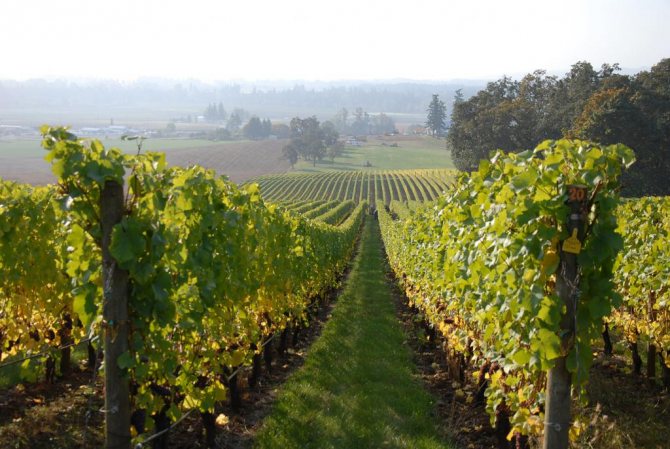

Pruning
Libya grapes are very responsive to pruning and endows with high-quality tasty brushes. It is recommended to cut the vine by 2-6 eyes.
When performing the formation of the vine, no more than four yield arms should be left, which must be shortened in the autumn. When blooming, remove excess ovaries. Overloading negatively affects grape yields in Libya.
Libya cannot be overwhelmed. No more than fifty buds are left on one vine. Young plants are cut shorter, leaving no more than four buds.
An important feature of the variety is that fruiting is shifted to the base of the vine.
Further care of grapes Libya
Further care of the Libya vineyard consists in observing the irrigation regime, applying top dressing, loosening near-trunk circles, removing weeds, mulching the soil, pruning vines and preparing them for winter.
Photo of the size and shape of grapes Libya
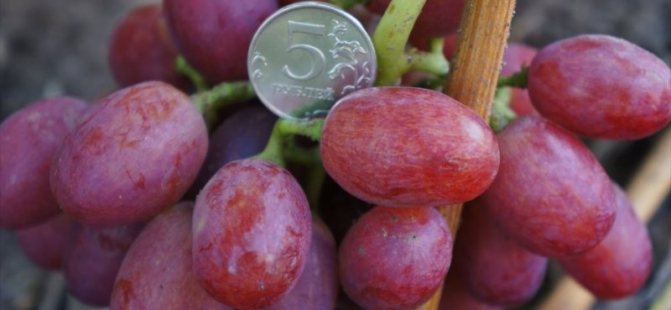

The vineyard is watered for the first time after the winter shelter has been removed.
To do this, a solution of wood ash is poured under each vine (a pound of ash is diluted in 4 liters of water).
5-7 days before the beginning of budding and during the active formation of ovaries, watering is repeated.
When the fruits begin to pour, they stop watering the grapes.
Need to know!
To make it easier to care for the vineyard, all shoots are tied to trellises or supports.
Caring for grapes before flowering - video
During the ripening period of the brushes, birds, wasps and bees can attack the berries. To protect the harvest, the grape bushes are covered with a special net that allows oxygen and light to pass through, but does not allow pests to spoil the fruit.
Birds can be scared away by hanging mirrors, old toys, tape or iron covers in the vineyard.
Libya grapes: plant nutrition
As fertilizers for the berry culture of Libya grapes, you need to use:
- organic matter (cow dung, bird droppings, ash);
- mineral supplements (urea, superphosphate and potassium salt).
Photo of preparation for feeding grapes
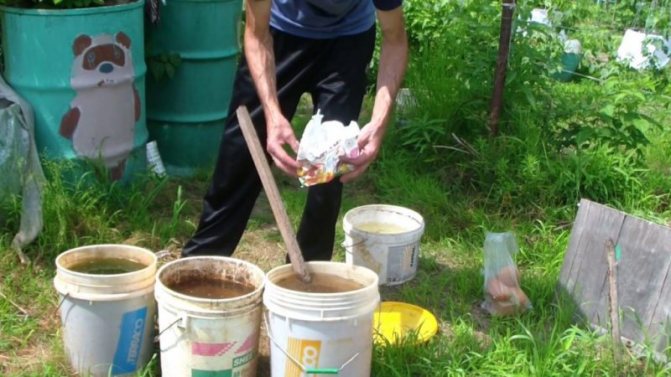

During the growing season, the vines require a large amount of nitrogen, and during the flowering and ripening of fruits - fertilizers containing potassium and phosphorus.
Top dressing of grapes - video
Pruning grapes Libya
In the autumn, short pruning of the shoots of the Libya grape variety is practiced - no more than 5 eyes are left on them. With spring formative pruning, it is required to remember that the maximum load on these vines is no more than 40 eyes.
Photo of the formative pruning of grapes Libya


Libya grape pruning procedure should be carried out before the beginning of sap flow in spring and after leaf fall in autumn.
In this case, it is imperative to remove all damaged, old, dried or frozen branches.
To reduce the load on the vines with the harvest, extra ovaries are removed on the shoots, leaving no more than 2 brushes on each stem.
Pruning and garter grapes Libya - video
Preparing vines for winter
After the end of the leaf fall, up to 30 liters of water is added under each plant, which will help the root system to prepare for the cold weather. Then potash-phosphorus fertilizers are applied under each bush.
Photo of an example of grape shelter with agrofibre
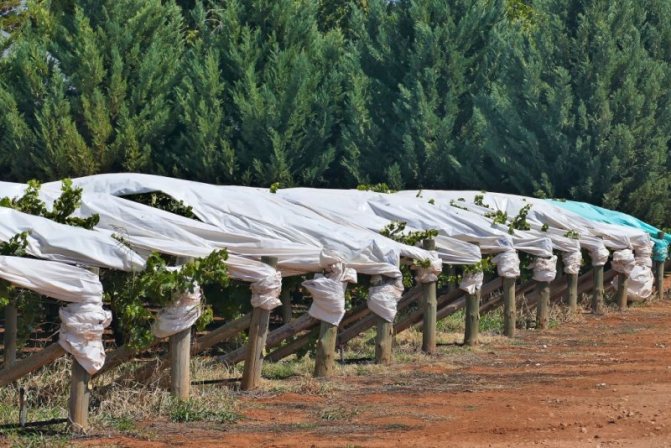

Immediately before frost, the grape bushes are removed from the trellises, laid on the ground and covered with a thick layer of earth.
After the air temperature drops to -3-5 degrees Celsius, agrofibre or burlap is laid on top of the ground. To protect the vines
from mice and other rodents, roofing material or other special covering material can be used as a shelter.
Spruce branches should be placed on top of the covering material, and in winter, snow should be scooped up to the plants.
Gardeners' opinions about the variety
The new hybrid has found its admirers. There are also gardeners who did not like the variety. What is attractive in Libya is that the variety gives large clusters and tasty berries with a pleasant aroma, which can be stored for a month without losing qualities.
The disadvantage is the need to cover the vine and insufficient color of the berries. Also, the variety is not liked by gardeners because of its instability to some diseases. However, if processing is carried out in a timely manner, then the culture will not get sick.
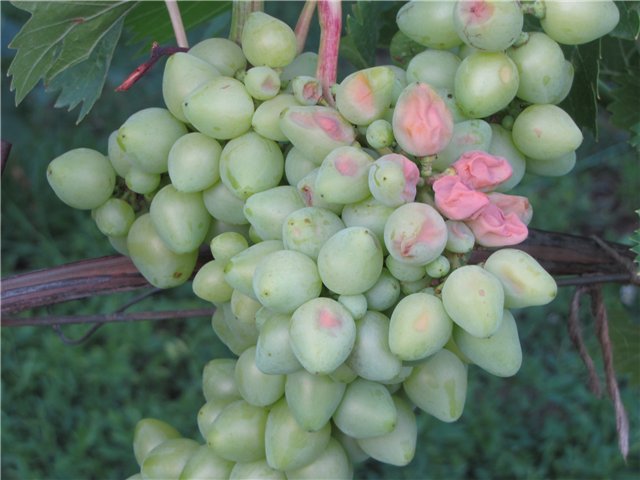

Testimonials
- Ekaterina, 32 years old: “The variety Libya has been growing at my dacha for the 5th year already. He began to bear fruit for me for 3 years. The berries are very sweet and juicy. I make delicious jam out of them. I only planted 4 bushes near the house. From one I can get about 4-5 kg. The variety is unpretentious in care. I water it every 3 weeks, since I laid out the sawdust mulch. For the winter I cover the plant with spruce branches, as I live in the north. "
- Igor, 47 years old: “I planted the Libya variety 10 years ago. During this time, I managed to understand all the advantages and disadvantages of this variety. I really like that it is undemanding to care for, gives a high yield, is quite resistant to disease. But when planting it, it is important to choose the right place. If you plant a culture in a shaded area, then it will not develop and may even die. Besides, it is important to fertilize and water on time ”.
It will also be useful and interesting to learn about the existing reviews of Crystal grapes, as well as see a photo of the variety.
Mildew
Most often, Libya is sick with mildew and powdery mildew.
Downy mildew, or mildew, is considered the most common disease in grape crops. It affects all green parts of the crop, including berries. The disease is caused by a fungus.
The first signs of the disease are the appearance of a rounded oily spot on the upper part of the still growing leaves. In wet weather, a white bloom forms on the underside of the stain. Gradually, the tissues begin to die off: necrosis takes over more and more areas. First, the affected tissue turns yellow, then the stain becomes reddish-brown with vivid processes of death and drying. With severe lesions, the foliage falls off. After the initial manifestation of mildew on the leaves, the fungus passes to the inflorescences and bunches with the harvest. On the brushes, the comb is affected: a green spot appears on it, as if soaked in water. If the mycelium penetrates into the peduncle, ovaries, flowers, inflorescences, clusters of berries, then the entire brush is covered with a white bloom, then the flowers and buds fall off, the berries crumble.
The most favorable conditions for the development of the disease are temperatures of 20-25 degrees and high humidity.
To combat the disease, it is recommended to carry out timely feeding with phosphorus-potassium fertilizers, remove stepchildren, and carry out preventive treatments with fungicides. The first is carried out during the period when young shoots reach a length of twenty centimeters. The second treatment is carried out before flowering, and when the berries reach the size of a pea, a third treatment is carried out.For mildew, the following drugs are used: Antracol, Bordeaux mixture, Strobi, copper oxychloride, Thanos, etc.
Diseases and pests of grapes
The resistance of Libya grapes to major diseases and pest attacks is average.
To protect against powdery and downy mildew, regular preventive spraying is required.
Photo of powdery mildew on grape leaves
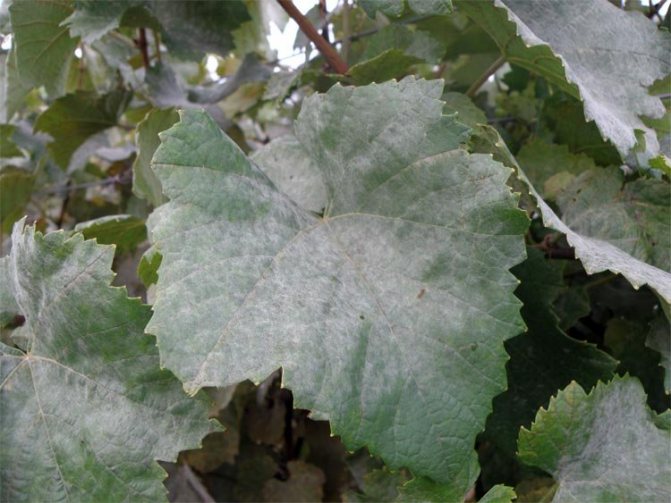

Oidium, or powdery mildew
Most damage to grapes is caused by powdery mildew, or powdery mildew. The disease is also caused by a fungus. Signs of the disease are lagging in growth and development of shoots, curly leaves, white-gray bloom on the upper side of the leaf. The bunches of grapes and the tops of the shoots look like they have been sprinkled with flour. Infected berries burst, lag behind in development, then dry out.
Oidium causes great damage to the crop. To save him, it is necessary to carry out prevention of the disease, and in cases of infection - treatment with drugs "Strobi", "Topaz", "Tiovit", etc.






